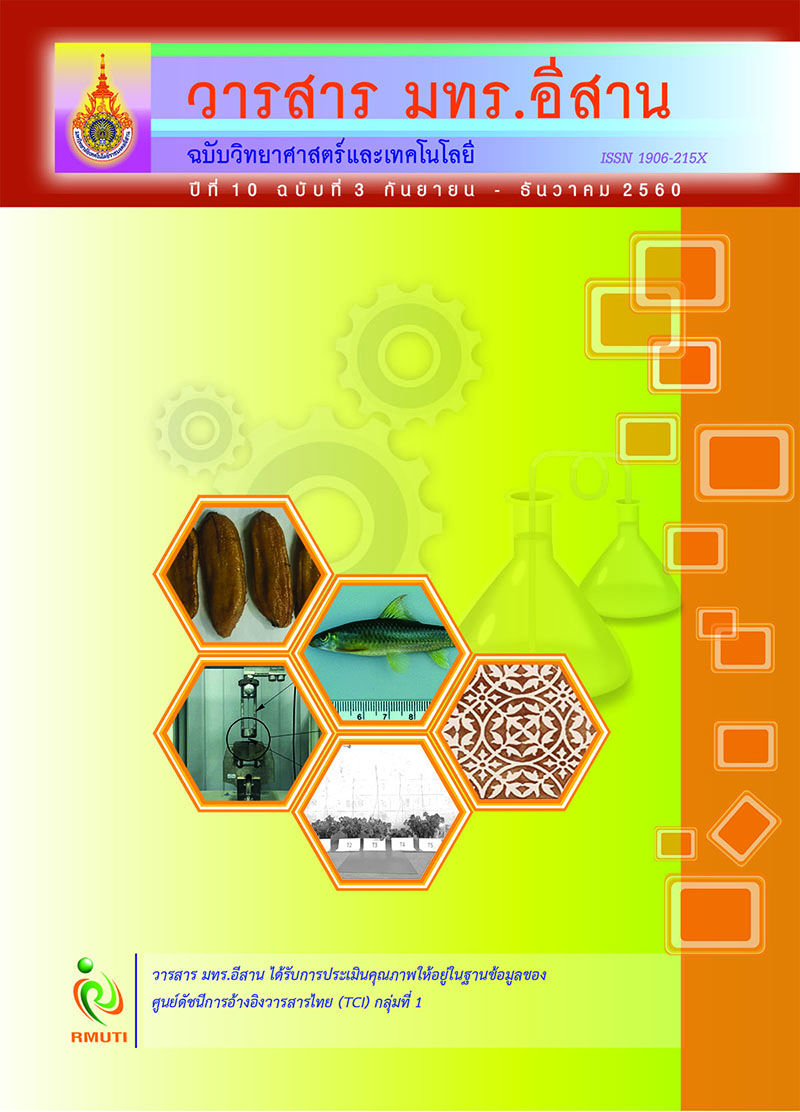การพิมพ์สีธรรมชาติจากเปลือกลูกจากแห้งด้วยเทคนิคการพิมพ์กั้นสี Natural Dye Printing from Dried Nipa Palm Shell via Resist Printing Technique
Main Article Content
บทคัดย่อ
บทคัดย่อ
งานวิจัยนี้มีวัตถุประสงค์หลักเพื่อหาภาวะที่เหมาะสมในการพิมพ์สีธรรมชาติจากเปลือกลูกจาก และการทำลวดลายบนวัสดุสิ่งทอด้วยเทคนิคการพิมพ์กั้นสี การพิมพ์กั้นสีเป็นเทคนิคการพิมพ์เฉพาะตัวอาศัย
หลักการรบกวนกลไกการติดสีบริเวณที่ต้องการเพื่อให้เกิดลวดลายสีขาวบริเวณที่ต้องการ การพิมพ์นี้ให้ผลการพิมพ์ลวดลายที่คมชัดกว่าการพิมพ์รูปแบบเดิม การศึกษาเริ่มจากการสกัดสีจากเปลือกลูกจากแห้งหาประเภทเส้นใยและภาวะที่เหมาะสมในการติดสี จากนั้นหาประเภทสารเคมีและภาวะที่เหมาะสมสำหรับการทำลวดลายด้วยเทคนิคการพิมพ์กั้นสี ผลการศึกษาพบว่าสีจากเปลือกลูกจากแห้งสามารถติดสีได้ดีบนผ้าไหมในภาวะกรด ดังนั้นการพิมพ์กั้นสีจึงใช้โซเดียมคาร์บอเนตความเข้มข้นร้อยละ 30 โดยนํ้าหนัก เป็นสารกั้นสีหลักในการป้องกันการติดสี และกรดซิตริกความเข้มข้นร้อยละ 8 โดยนํ้าหนักเป็นสารเคมีหลักในการพิมพ์สีพื้น จากนั้นนำผ้าที่ได้ไปผนึกสีด้วยไอนํ้าเวลา 15 นาที ผลการศึกษาพบว่าบริเวณสีพื้นได้สีนํ้าตาลแดง มีความเข้มสี 3.12 และได้ผลการพิมพ์สีขาวที่ชัดเจนบริเวณลวดลายมีค่าดัชนีความขาวเท่ากับ 35.05 ผ้าพิมพ์ที่ได้นำไปทดสอบความคงทนของสีต่อการซักล้าง การขัดถู และแสงแดดพบว่าให้ผลความคงทนของสีในระดับปานกลางถึงดี สรุปได้ว่าเปลือกลูกจากแห้งสามารถนำมาใช้ประโยชน์ในการพิมพ์สิ่งทอ และสร้างลวดลายด้วยเทคนิคการพิมพ์กั้นสี ถือเป็นอีกหนึ่งช่องทางในการใช้งานและการเพิ่มมูลค่าให้แก่เปลือกลูกจากแห้ง
Abstract
This research mainly aims to find an appropriate condition for printing natural dye from dry Nipa palm shell and patterns printing using resist printing Technique on textile substrates. Resist printing technique is a specific technique that relies on deducting disturbance of staining mechanism on areas demanded to be printed. Consequently, such areas would become white with pattern. This type of printing provids sharper printing result than conventional printing. The study was started with dye extraction from dried Nipa palm shell and finding appropriate fiber type and conditions for dyeing Nipa palm shell dye. Then, the suitable resisting agent and optimal resisting printing process were investigated. The results showed that the dye from dried nipa palm shell was dyeable on silk fabric in acidic condition. Therefore, in order to create a resisting effect, 30 %w/w Sodium carbonate was used as a resisting agent and 8 %w/w of citric acid was used as a mainly auxiliary for ground shade printing. The printed fabrics were fixed by steaming for 15 minutes. The results showed a red-brown color on ground shade with the color strength (K/S) of 3.12 and cleared white color on the resisted area with the whiteness index of 35.05. The color fastnesses to washing, crocking and light were moderate to good level. It could be concluded that the dried Nipa palm shell could be utilized for textile printing aiming to create a resist printing effect. This could be considered as another channel for utilizing and adding value to dried nipa palm shell.
Article Details
เอกสารอ้างอิง
[2] Kietkwanboot, Anukool. (2013). Decolorization and Biodegradation of Phenolics in Palm Oil Mill Effluent by White Rot Fungi Immobilized on Oil Palm Residues. M.Sc. Thesis in Environmental Management. Prince of Songkla University, Songkla (in Thai)
[3] Farid, Hossain and Anwarul, Islam. (2015). Utilization of Mangrove Forest Plant: Nipa Palm (Nypa fruticans Wurmb). American Journal of Agriculture and Forestry. Vol. 3. No. 4. pp. 156-160
[4] Pramila, Tamunaidu and Shiro, Saka. (2011). Chemical Characterization of Various Parts of Nipa Palm (Nypa Fruticans). Industrial Crops and Products. Vol. 34. No. 3. pp. 1423-1428
[5] Pawongrat, Ratchapol. (2015). Pretreatment Processes for Enhancing the Efficiency of Ethanol Production from Lignocellulosic Agricultural Wastes. Veridian E-Journal, Science and Technology Silpakorn University. Vol. 2. No. 1. pp. 143-157 (in Thai)
[6] Prasil, Miroslave. (2008). Textile Printing: Chemical Part. Technical University of Liberec, Liberec.
[7] Gohl, E.P.G. and Vilensky, L.D. (2005). Textile Science: An Explanation of Fibre Properties. 2nd edition. Delhi : CBS Publishers & Distributors PVT. Ltd.
[8] Luepong, Kanchana. (2010). TEXTILE PRINTING SYSTEM 1. Rajamangala University of Technology Phra Nakhon, Bangkok (in Thai)


